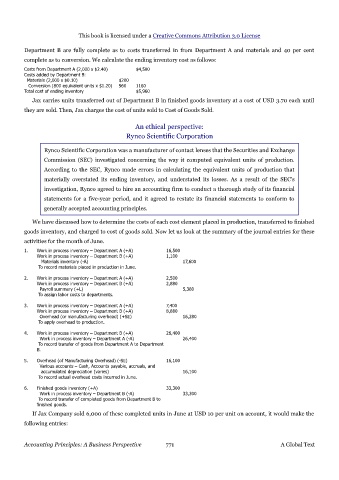Page 770 - Accounting Principles (A Business Perspective)
P. 770
This book is licensed under a Creative Commons Attribution 3.0 License
Department B are fully complete as to costs transferred in from Department A and materials and 40 per cent
complete as to conversion. We calculate the ending inventory cost as follows:
Costs from Department A (2,000 x $2.40) $4,500
Costs added by Department B:
Materials (2,000 x $0.10) $200
Conversion (800 equivalent units x $1.20) 960 1160
Total cost of ending inventory $5,960
Jax carries units transferred out of Department B in finished goods inventory at a cost of USD 3.70 each until
they are sold. Then, Jax charges the cost of units sold to Cost of Goods Sold.
An ethical perspective:
Rynco Scientific Corporation
Rynco Scientific Corporation was a manufacturer of contact lenses that the Securities and Exchange
Commission (SEC) investigated concerning the way it computed equivalent units of production.
According to the SEC, Rynco made errors in calculating the equivalent units of production that
materially overstated its ending inventory, and understated its losses. As a result of the SEC's
investigation, Rynco agreed to hire an accounting firm to conduct a thorough study of its financial
statements for a five-year period, and it agreed to restate its financial statements to conform to
generally accepted accounting principles.
We have discussed how to determine the costs of each cost element placed in production, transferred to finished
goods inventory, and charged to cost of goods sold. Now let us look at the summary of the journal entries for these
activities for the month of June.
1. Work in process inventory – Department A (+A) 16,500
Work in process inventory – Department B (+A) 1,100
Materials inventory (-A) 17,600
To record materials placed in production in June.
2. Work in process inventory – Department A (+A) 2,500
Work in process inventory – Department B (+A) 2,880
Payroll summary (+L) 5,380
To assign labor costs to departments.
3. Work in process inventory – Department A (+A) 7,400
Work in process inventory – Department B (+A) 8,880
Overhead (or manufacturing overhead) (+SE) 16,280
To apply overhead to production.
4. Work in process inventory – Department B (+A) 26,400
Work in process inventory – Department A (-A) 26,400
To record transfer of goods from Department A to Department
B.
5. Overhead (of Manufacturing Overhead) (-SE) 16,100
Various accounts – Cash, Accounts payable, accruals, and
accumulated depreciation (varies) 16,100
To record actual overhead costs incurred in June.
6. Finished goods inventory (+A) 33,300
Work in process inventory – Department B (-A) 33,300
To record transfer of completed goods from Department B to
finished goods.
If Jax Company sold 6,000 of these completed units in June at USD 10 per unit on account, it would make the
following entries:
Accounting Principles: A Business Perspective 771 A Global Text

